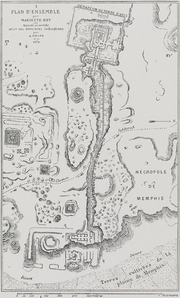
Back سرابيوم (سقارة) Arabic Serapeu de Saqqara Catalan Serapeum (Sakkara) German Σεραπείο της Σακκάρα Greek Serapeum de Saqqara Spanish Saqqarako Serapeuma Basque Sérapéum de Saqqarah French Serapeum van Saqqara Dutch Serapeum de Saqqara Occitan Serapeum w Sakkarze Polish
| |||||
 Entrance ramp to the burial vaults | |||||
| Location | Saqqara | ||||
|---|---|---|---|---|---|
| Coordinates | 29°52′34″N 31°12′36″E / 29.876°N 31.210°E | ||||
| Type | Serapeum | ||||
| History | |||||
| Builder | Amenhotep III - Cleopatra | ||||
| Founded | c. 1400 BC | ||||
| Abandoned | c. 30 BC | ||||
| Periods | New Kingdom - Ptolemaic Egypt | ||||
| Site notes | |||||
| Excavation dates | 1850–1853; 2020–present | ||||
| Archaeologists | Auguste Mariette | ||||
| Public access | Limited | ||||
The Serapeum of Saqqara was the ancient Egyptian burial place for sacred bulls of the Apis cult at Memphis. It was believed that the bulls were incarnations of the god Ptah, which would become immortal after death as Osiris-Apis, a name which evolved to Serapis (Σέραπις) in the Hellenistic period, and Userhapi (ⲟⲩⲥⲉⲣϩⲁⲡⲓ) in Coptic. It is one of the animal catacombs in the Saqqara necropolis, which also contains the burial vaults of the mother cows of the Apis, the Iseum.[2]
Over a timespan of approximately 1400 years, from the New Kingdom of Egypt to the end of the Ptolemaic Period, at least sixty Apis are attested to have been interred at the Serapeum. For the earliest burials, isolated tombs were constructed. As the cult gained importance, underground galleries were dug that connected subsequent burial chambers. Above ground, the main temple enclosure was supplemented by shrines, workshops, housing and administrative quarters.[3]
From the Late Period onward, most Apis were buried in large sarcophagi, which weigh around 40 tonnes (88,000 lb) and have 25 t (55,000 lb) lids. They were moved with the help of winches, rollers and levers. To lower them into their final position the chambers were first filled with sand, which was then gradually removed. Only four of the 24 surviving sarcophagi are inscribed. The quality of the inscriptions varies, the ones of Amasis II were beautifully executed, whereas those on an anonymous sarcophagus were only crudely scratched on the polished surface.[4]
The Serapeum was closed in the beginning of the Roman period, after 30 BC. In the subsequent centuries large-scale looting took place. Many of the superstructures were dismantled, the burial vaults broken into, and most of the mummified Apis and their opulent burial goods removed.
In 1850 Auguste Mariette rediscovered the Serapeum, and excavated it the following years. He found two undisturbed Apis burials, as well as thousands of objects related to centuries of cult activity. These included commemorative stela with dates relating to the life and death of the Apis and the construction of their burial vaults. This data was crucial for the establishment of an Egyptian chronology in the 19th century.
The Greater Vaults of the Serapeum, known for the large sarcophagi of the mummified bulls, are accessible to visitors.[5]
- ^ Otto, Eberhard (1964). Untersuchungen zur Geschichte und Altertumskunde Aegyptens (PDF) (in German). Vol. 13. p. 19.
- ^ Dodson 2005, pp. 89–91.
- ^ Marković 2017, p. 152.
- ^ Gunn 1926b, p. 94.
- ^ "Ministry of Tourism and Antiquities - Serapeum". egymonuments.gov.eg. Retrieved 2022-04-25.


